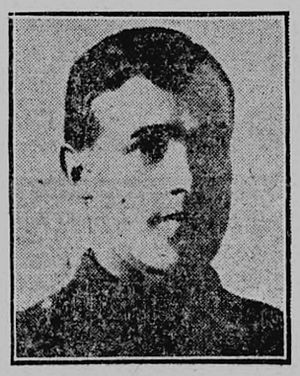George Prowse facts for kids
Quick facts for kids
George Henry Prowse
|
|
|---|---|
 |
|
| Born | 29 August 1886 Brynsion Terrace, Gilfach Goch |
| Died | 27 September 1918 (aged 32) Anneux, France |
| Allegiance | |
| Service/ |
|
| Years of service | 1915–1918 |
| Rank | Chief Petty Officer |
| Unit | Drake Battalion |
| Battles/wars | World War I |
| Awards | Victoria Cross Distinguished Conduct Medal |
George Henry Prowse was a brave British sailor. He was a Chief Petty Officer in the Royal Naval Division. He is famous for receiving two very important awards. These were the Victoria Cross (VC) and the Distinguished Conduct Medal (DCM).
The Victoria Cross is the highest award for bravery. It is given to soldiers and sailors who show amazing courage. This is especially true when they face the enemy. George Prowse fought in World War I. He served in the Gallipoli Campaign and later in France. He died in battle before his awards were officially announced.
George Prowse was born on August 29, 1886. His birthplace was Brynsion Terrace in Gilfach Goch, Wales. A special Blue plaque now marks his childhood home. This plaque celebrates his life and bravery.
Before joining the navy, George worked as a collier. This means he worked in a coal mine. He lived in Swansea, Wales, with his wife, Sarah. He was a tall man, about 6 feet (1.8 meters) tall.
George joined the Royal Navy Volunteer Reserve in 1915. He became an Ordinary Seaman (rating) at first. Soon after, he was promoted to Able Seaman (rank). He trained at a place called Blandford.
In September 1915, he joined the Drake Battalion. This group was fighting in the Gallipoli Campaign. George had some health issues during this time. He later rejoined his battalion in Egypt.
Fighting in France
In May 1916, George's division moved to France. They arrived in Marseilles in June. On June 20, he was promoted again. He became a Petty Officer.
In November 1916, his division fought in the Battle of the Ancre. This was a big battle during the Battle of the Somme. George was wounded in his left leg. He was treated in hospitals in France and England.
After recovering, he returned to his battalion. This was in France on March 28, 1917.
Amazing Bravery
In August 1918, George Prowse was recognized for his bravery. He was recommended for the Distinguished Conduct Medal (DCM). This award was given to him after he died.
The award description told of his actions on August 21, 1918. He bravely led his men against an enemy machine gun. There was a heavy mist, but he still captured the gun. He also dealt with the enemy crew.
Later, he held a position against many enemy attacks. These attacks lasted for 24 hours. His courage and leadership helped his men greatly. He always kept a cheerful attitude.
George Prowse was about 32 years old. He was a Chief Petty Officer when he earned the Victoria Cross. This happened on September 2, 1918, in Pronville, France.
He led a small group of men against a strong enemy position. They captured it! They also took 23 prisoners and 5 machine guns. On other occasions, he showed incredible heroism. He bravely attacked and captured two more machine-gun posts. He killed six enemy soldiers and took 13 prisoners. He also captured two more machine guns.
George was the only survivor of this brave group. His actions helped his battalion move forward safely.
His Medals
George Prowse died in battle. So, his wife, Sarah, received his Victoria Cross. King George V presented it to her. This happened at Buckingham Palace on July 17, 1919. Sarah was the first person to receive a posthumous (after death) VC that day.
Today, George Prowse's Victoria Cross is part of the Lord Ashcroft VC Collection. You can see it at the Imperial War Museum.
Images for kids


